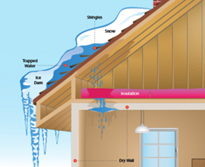Here are some helpful winter tips regarding Frozen Pipes and Ice Dams to help you do everything possible to be prepared for this COLD New England winter season!!
Preventing Frozen Pipes

How to determine if you have a frozen pipe:
- Turn on each water supply faucet (both hot and cold) to ensure that there is a steady stream of water.
- If the flow of water is slowed or there is no flow, then it is likely that your pipe has frozen.
What to do if you have a frozen pipe:
- Identify the blockage (probably the area of most exposure) and use a blow dryer (do NOT use an open flame torch!) to heat the supply line, while leaving the faucet open.
- Continue heating the pipe until there is a steady flow of water.
Tips for keeping your pipes from freezing:
- Insulate all accessible pipes using pipe insulation (this can be found at your local hardware store).
- Before it gets too cold, seal all cracks, holes, and other openings on the exterior walls with caulk or insulation.
- If the temperature drops lower than usual and you have pipes in cabinets or closets, leave the cabinet/closet doors open or use a fan to increase warm air circulation around the pipes.
- Pay close attention to local weather reports and prepare for extreme cold weather.
- When extreme cold weather is predicted, let all faucets drip to prevent freezing of the water inside the pipe, and if freezing does occur, to relieve pressure buildup in the pipes between the ice blockage and the faucet. The pressure buildup is the actual cause of bursting pipes.
- Shut off the water supply during periods when the home may be unoccupied, particularly when cold weather is expected.
Preventing Ice Dams

Don’t let winter get the best of you! We want to help you prepare and survive this winter season. By now you’re probably well aware of ice dams and all the trouble they caused during the record-breaking winter of 2014-2015! But just in case, we wanted to share some tips on ice dam preparation and prevention.
What is an Ice Dam?
Ice dams are ridges of ice that form at the edge of a roof and prevent melting snow from draining off your roof.
Water that backs up behind the dam can leak into your home and cause damage. Walls, insulation and ceilings are at the greatest risk for damage. Look for these warning signs:
- Large icicles hanging from gutters
- Water dripping from the roof overhang
- Leaks, stains or damaged ceilings or walls inside your home
What to do if you have an Ice Dam?
Remove the first three to four feet of snow from the roofline with a roof rake or soft bristled broom. If the home is too tall to reach the roof then hire a roofing professional to clear the snow. Contact your insurance company right away if you notice water leaking into your home.
Contact us at 978-352-8000 or info [at] georgetowninsurance [dot] com if you have any questions about this and other insurance topics. We are always here to help you make insurance decisions and answer questions you have about your policy. Wishing you a safe, happy and warm holiday season!

Discussion
There are no comments yet.